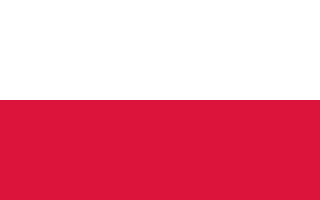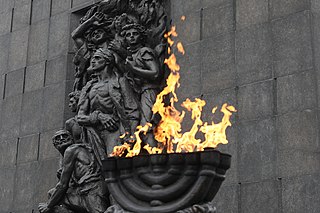Related Research Articles

Auschwitz concentration camp, also known as Oświęcim concentration camp, was a complex of over 40 concentration and extermination camps operated by Nazi Germany in occupied Poland during World War II and the Holocaust. It consisted of Auschwitz I, the main camp (Stammlager) in Oświęcim; Auschwitz II-Birkenau, a concentration and extermination camp with gas chambers; Auschwitz III-Monowitz, a labour camp for the chemical conglomerate IG Farben; and dozens of subcamps. The camps became a major site of the Nazis' Final Solution to the Jewish question.

Gdańsk is a city on the Baltic coast of northern Poland, and the capital of the Pomeranian Voivodeship. With a population of 486,492, it is Poland's sixth-largest city and principal seaport. Gdańsk lies at the mouth of the Motława River and is situated at the southern edge of Gdańsk Bay, close to the city of Gdynia and the resort town of Sopot; these form a metropolitan area called the Tricity (Trójmiasto), with a population of approximately 1.5 million.

The Second Polish Republic, at the time officially known as the Republic of Poland, was a country in Central and Eastern Europe that existed between 7 October 1918 and 6 October 1939. The state was established in the final stage of World War I. The Second Republic ceased to exist in 1939, after Poland was invaded by Nazi Germany, the Soviet Union, and the Slovak Republic, marking the beginning of the European theatre of the Second World War. The Polish government-in-exile was established in Paris and later London after the fall of France in 1940.

Kraków, also spelled as Cracow or Krakow, is the second-largest and one of the oldest cities in Poland. Situated on the Vistula River in Lesser Poland Voivodeship, the city has a population of 804,237 (2023), with approximately 8 million additional people living within a 100 km (62 mi) radius. Kraków was the official capital of Poland until 1596, and has traditionally been one of the leading centres of Polish academic, cultural, and artistic life. Cited as one of Europe's most beautiful cities, its Old Town was declared a UNESCO World Heritage Site in 1978, one of the world's first sites granted the status.

Poland, officially the Republic of Poland, is a country in Central Europe. It extends from the Baltic Sea in the north to the Sudetes and Carpathian Mountains in the south, bordered by Lithuania and Russia to the northeast, Belarus and Ukraine to the east, Slovakia and the Czech Republic to the south, and Germany to the west. The territory is characterised by a varied landscape, diverse ecosystems, and temperate transitional climate. Poland is composed of sixteen voivodeships and is the fifth most populous member state of the European Union (EU), with over 38 million people, and the fifth largest EU country by land area, covering a combined area of 312,696 km2 (120,733 sq mi). The capital and largest city is Warsaw; other major cities include Kraków, Wrocław, Łódź, Poznań, Gdańsk, and Szczecin.

Polish is a West Slavic language of the Lechitic group within the Indo-European language family written in the Latin script. It is primarily spoken in Poland and serves as the official language of the country, as well as the language of the Polish diaspora around the world. In 2024, there were over 39.7 million Polish native speakers. It ranks as the sixth most-spoken among languages of the European Union. Polish is subdivided into regional dialects and maintains strict T–V distinction pronouns, honorifics, and various forms of formalities when addressing individuals.

Szczecin is the capital and largest city of the West Pomeranian Voivodeship in northwestern Poland. Located near the Baltic Sea and the German border, it is a major seaport and Poland's seventh-largest city. As of 31 December 2022, the population was 391,566.

Warsaw, officially the Capital City of Warsaw, is the capital and largest city of Poland. The metropolis stands on the River Vistula in east-central Poland. Its population is officially estimated at 1.86 million residents within a greater metropolitan area of 3.27 million residents, which makes Warsaw the 7th most-populous city in the European Union. The city area measures 517 km2 (200 sq mi) and comprises 18 districts, while the metropolitan area covers 6,100 km2 (2,355 sq mi). Warsaw is classified as an alpha global city, a major cultural, political and economic hub, and the country's seat of government. It is also the capital of the Masovian Voivodeship.

Wrocław is a city in southwestern Poland and the largest city and historical capital of the region of Silesia. It lies on the banks of the Oder River in the Silesian Lowlands of Central Europe, roughly 40 kilometres (25 mi) from the Sudeten Mountains to the south. As of 2023, the official population of Wrocław is 674,132 making it the third largest city in Poland. The population of the Wrocław metropolitan area is around 1.25 million.

Polish people, or Poles, are a West Slavic ethnic group and nation who share a common history, culture, the Polish language and are identified with the country of Poland in Central Europe. The preamble to the Constitution of the Republic of Poland defines the Polish nation as comprising all the citizens of Poland, regardless of heritage or ethnicity. The majority of Poles adhere to Roman Catholicism.

The Invasion of Poland, also known as the September Campaign, Polish Campaign, and Polish Defensive War of 1939, was a joint attack on the Republic of Poland by Nazi Germany, the Slovak Republic, and the Soviet Union, which marked the beginning of World War II. The German invasion began on 1 September 1939, one week after the signing of the Molotov–Ribbentrop Pact between Germany and the Soviet Union, and one day after the Supreme Soviet of the Soviet Union had approved the pact. One of the aims of the invasion was to divide Polish territory at the end of the operation; Poland was to cease to exist as a country and all Poles were to be exterminated. The Soviets invaded Poland on 17 September. The campaign ended on 6 October with Germany and the Soviet Union dividing and annexing the whole of Poland under the terms of the German–Soviet Frontier Treaty. The invasion is also known in Poland as the September campaign or 1939 defensive war and known in Germany as the Poland campaign.

The Polish–Lithuanian Commonwealth, formally known as the Kingdom of Poland and the Grand Duchy of Lithuania and also referred to as Poland–Lithuania or the First Polish Republic, was a federative real union between the Kingdom of Poland and the Grand Duchy of Lithuania, existing from 1569 to 1795. This state was among the largest and most populated countries of 16th- to 17th-century Europe. At its peak in the early 17th century, the Commonwealth spanned nearly 1,000,000 km2 (390,000 sq mi) and supported a multi-ethnic population of approximately 12 million as of 1618. The official languages of the Commonwealth were Polish and Latin, with Catholicism as the state religion.

The Polish–Soviet War was fought primarily between the Second Polish Republic and the Russian Soviet Federative Socialist Republic, following World War I and the Russian Revolution.

The Polish People's Republic (1952–1989), formerly the Republic of Poland (1947–1952), and also often simply known as Poland, was a country in Central Europe that existed as the predecessor of the modern-day democratic Republic of Poland. With a population of approximately 37.9 million near the end of its existence, it was the second most-populous communist and Eastern Bloc country in Europe, and one of the main signatories of the Warsaw Pact alliance. The largest city and official capital since 1947 was Warsaw, followed by the industrial city of Łódź and cultural city of Kraków. The country was bordered by the Baltic Sea to the north, the Soviet Union to the east, Czechoslovakia to the south, and East Germany to the west.

The Warsaw Uprising, sometimes referred to as the August Uprising, was a major World War II operation by the Polish underground resistance to liberate Warsaw from German occupation. It occurred in the summer of 1944, and it was led by the Polish resistance Home Army. The uprising was timed to coincide with the retreat of the German forces from Poland ahead of the Soviet advance. While approaching the eastern suburbs of the city, the Red Army halted combat operations, enabling the Germans to regroup and defeat the Polish resistance and to destroy the city in retaliation. The Uprising was fought for 63 days with little outside support. It was the single largest military effort taken by any European resistance movement during World War II. The defeat of the uprising and suppression of the Home Army enabled the pro-Soviet Polish administration, instead of the Polish government-in-exile based in London, to take control of Poland afterwards. Poland would remain as part of the Soviet-aligned Eastern Bloc throughout the Cold War until 1989.

The history of the Jews in Poland dates back at least 1,000 years. For centuries, Poland was home to the largest and most significant Ashkenazi Jewish community in the world. Poland was a principal center of Jewish culture, because of the long period of statutory religious tolerance and social autonomy which ended after the Partitions of Poland in the 18th century. During World War II there was a nearly complete genocidal destruction of the Polish Jewish community by Nazi Germany and its collaborators of various nationalities, during the German occupation of Poland between 1939 and 1945, called the Holocaust. Since the fall of communism in Poland, there has been a renewed interest in Jewish culture, featuring an annual Jewish Culture Festival, new study programs at Polish secondary schools and universities, and the opening of Warsaw's Museum of the History of Polish Jews.

The Massacres of Poles in Volhynia and Eastern Galicia were carried out in German-occupied Poland by the Ukrainian Insurgent Army (UPA), with the support of parts of the local Ukrainian population, against the Polish minority in Volhynia, Eastern Galicia, parts of Polesia, and the Lublin region from 1943 to 1945.

The Polish Air Force is the aerial warfare branch of the Polish Armed Forces. Until July 2004 it was officially known as Wojska Lotnicze i Obrony Powietrznej. In 2014 it consisted of roughly 26,000 military personnel and about 475 aircraft, distributed among ten bases throughout Poland.

The Katyn massacre was a series of mass executions of nearly 22,000 Polish military and police officers, border guards, and intelligentsia prisoners of war carried out by the Soviet Union, specifically the NKVD, at Stalin's order in April and May 1940. Though the killings also occurred in the Kalinin and Kharkiv NKVD prisons and elsewhere, the massacre is named after the Katyn forest, where some of the mass graves were first discovered by Nazi German forces in 1943.

The Armed Forces of the Republic of Poland, also called the Polish Armed Forces and popularly called Wojsko Polskie in Poland, are the national armed forces of the Republic of Poland. The name has been used since the early 19th century, but can also be applied to earlier periods.